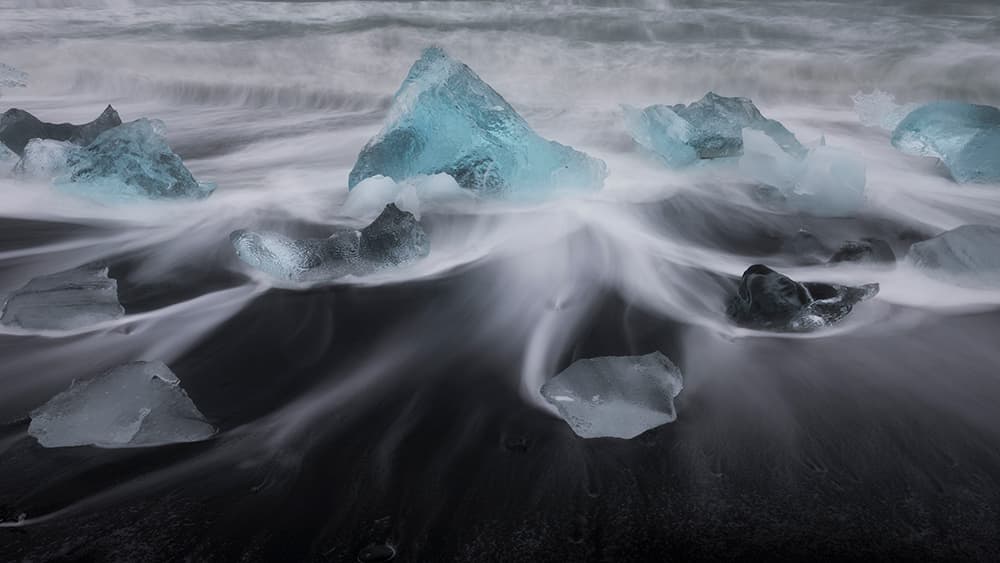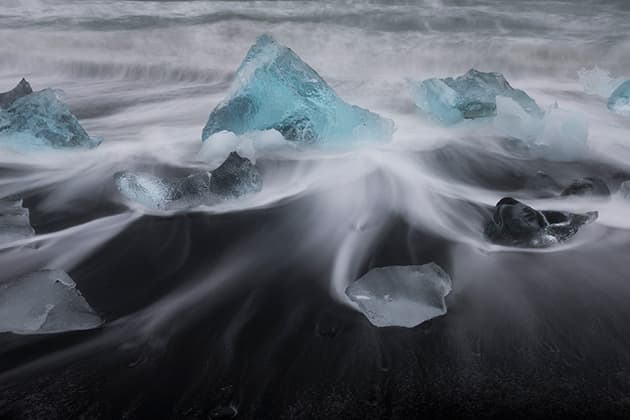
Nikon D810, 24-70mm, 2secs at f/11, ISO 64.
Iceland is one of those areas that are catnip for landscape photographers. It’s an area replete with stunning scenery and, perhaps most importantly, it’s very accessible. There are plenty of places to park and wherever you look there’s something to attract the eye. Iceland has everything, from snow-capped mountains, glaciers, volcanoes, cliffs, coasts, and plenty of rocks. There’s a lot for a photographer to shoot in what is a relatively small area.
It’s a naturally beautiful place and, aesthetically speaking, is unusual. When you visit, you can see why a lot of movie directors go there to shoot their films. There’s variety, and not just for landscape photographers. If you like photographing wildlife, there are copious species to see. Bird life is a big draw. You’ll witness everything from puffins to bigger birds such as sea eagles. It’s a massive cross-section of animal life. As an example, while standing on the beach one day, I witnessed a pod of nine killer whales. On another occasion, I saw an apparent mass herring suicide where they all jumped on to the beach and died. The birds were in for a good feast that day. And of course on top of everything else, you have the incredible display of the Northern Lights. So you can see why photographers like to travel all that distance. It’s bleak, but there’s a genuine beauty to it. It’s a weird landscape, almost lunar, maybe even a little post- apocalyptic.
On the beach
The images you see here were taken in Jökulsárlón, a glacial lake of southeast Iceland, on the edge of Vatnajökull National Park. The lumps of ice are icebergs, and they can drastically vary in size – some are several feet across. The ice has been washed down from the glacier, through the glacial lagoon, washed out to sea, then, during the next high tide, it is deposited back onto the black volcanic sand beaches. It happens in just this one place, so you get an awful lot of people going to that one area.
That raises the issue of how you go to an area like this and still come away with fresh images. It depends on several factors, for example, the nature of the tide at the time you visit, and how many other people are around. You’ll often get pristine sand and then you’ll get someone with a tripod walk through that sand and mess up the shot. But it also depends on how much ice and sand is there. Sometimes big storms come in and wash all the sand away; then the beach becomes a landscape of pebbles. It’s much nicer if it’s black sand. Basically, there are shots to be had, but there’s a danger of getting overloaded with blurry long exposures. It seems to be what people want to go and do.
Due to its nature, Iceland is a landscape in constant flux. I’ve never known a landscape change as much. You can have clear blue skies and calm seas one day then be faced with 15ft waves the next. Sometimes, the winds are so severe that the police have to close the roads. The coast is on the move all the time with the waves coming in – one day there will be a beach and the next it’s gone. Then a few days later, it’s back. It changes that much.

Nikon D810, 24-70mm, 2secs at f/11, ISO 64
Kit care
The camera I used for these shots was the Nikon D810 with a Nikon 24-70mm f/2.8 lens. I used a Gitzo Series 3 tripod with an Arca Swiss double pan head and quick release bracket for an easy transition from horizontal to vertical. Trying to photograph in a place like Jökulsárlón is almost a war of attrition. If it’s not raining, it’s snowing. If it’s not snowing, it’s incredibly windy. Then you’ve got all the volcanic dust flying around the air. It plays havoc with your kit. You’ll come back from a day’s shooting and your tripod and lens probably graunch with sand. It can be a nightmare.
Iceland is not a very camera-friendly place, with the conditions as they are. Just trying to keep your kit dry can be the biggest battle. I tend to keep my kit wrapped up with a big leather chamois cloth, secured with a bulldog clip. That means no moisture falls onto the camera and it reduces the risk of dust and sand getting into it. But sometimes you have to face the fact that if conditions get too bad, you just have to pack up. Even if it’s just windy you’re getting sea spray all over the place. You may notice that one of these shots is slightly softer than the other and that’s because salt was getting onto the lens. It’s knocked the contrast back a little bit.
When I’m shooting, I tend to have the Lee filter system on the front of my lens, perhaps a grad or a stopper of some sort. Then at least, if it’s really dusty, the filters will get scratched, not the lens. Filters are a lot easier and cheaper to replace.
If someone who has never visited Iceland asked me for advice, I’d say to go and expect the worst conditions possible for shooting. Then if they’re not that bad, you’ll be pleasantly surprised and you’ll enjoy it. But when I go, I go expecting bad weather and to have three or four days when I’m in rain all the time. It sounds pessimistic, but it’s good advice. Just be prepared. Pack your waterproofs, walking boots and overtrousers. You name it, you pack it.
Jeremy Walker, an award-winning professional photographer with many years’ experience specialising in high quality landscape and location photography from around the world for use by advertising, design and corporate clients. His belief in ‘quality is everything’ serves his clients well. www.jeremywalker.co.uk








